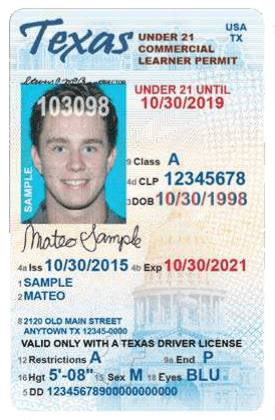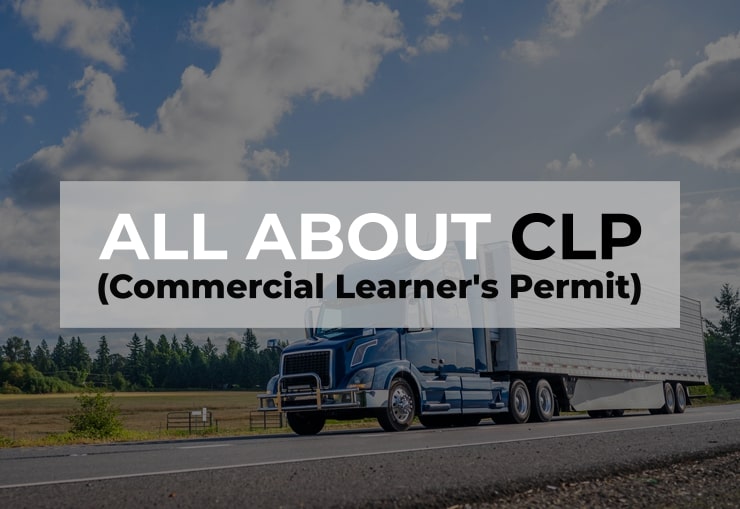In the trucking industry, obtaining a Commercial Learner’s Permit (CLP) marks the crucial first step toward a professional driving career, setting the stage for the eventual acquisition of a Commercial Driver’s License (CDL).
The CLP is vital as it allows aspiring drivers to gain hands-on experience under guidance, ensuring they develop the skills and knowledge necessary for safely operating large vehicles. This initial phase of holding a CLP is instrumental in shaping competent drivers who can confidently progress to a commercial driver license, further enhanced by specific endorsements, thereby unlocking a wide range of career opportunities with CDL and earned endorsements.
This guide is aimed at both aspiring and seasoned truckers. It guides you into the intricacies of obtaining a CLP, transitioning to a CDL, and the significance of various CDL endorsements. My goal is to equip you with essential knowledge, from understanding eligibility criteria and application processes to exploring the vast career opportunities these licenses and endorsements can unlock.
Let’s start exploring the key components of the CLP license and its substantial role in advancing your trucking career.
What is a CLP (Commercial Learner’s Permit)?
A Commercial Learner’s Permit (CLP) is the first step for individuals embarking on a career in trucking. It’s a permit that allows you to practice driving a commercial vehicle on public roads but with certain restrictions. Before you can commandeer a big rig on your own, the CLP is your entry ticket to the world of professional truck driving.
ℹ️
How to get a CLP (Commercial learner’s permit)?
The application process involves submitting the required documentation, which typically includes proof of identity, residency, and a medical examination report. A fee is also involved, varying by state. The written tests for the CLP assess your knowledge of commercial driving rules, safety regulations, and vehicle operation. These tests are crucial as they lay the groundwork for safe and responsible driving practices.
Here is a general step-by-step guide to get your commercial learner’s permit though don’t forget to check the procedure for your state.
1. Meeting Age Requirements.
Most states require applicants to be at least 18 years old for intrastate driving and 21 for interstate or hazardous materials transportation.
2. Read the State’s CDL Manual.
The CDL manual is crucial as it contains information on testing, CDL requirements, safe driving practices, and more. It can be downloaded from the state’s website or picked up from field locations.
3. Deciding on the Type of CLP and CDL.
Determine the class of CDL (Class A, B, or C) you aim to obtain, based on the type of vehicle you plan to drive. Consider if you need any CDL endorsements.
4. Completing a DOT Physical.
Some states require a DOT medical card or physical examination to ensure medical fitness for driving.
5. Applying for the CLP.
Applications can usually be made in person or online. Check with the local DMV regarding reservations and fee structures. You may also apply for endorsements during this step.
6. Proving Identity at the DMV.
Bring required documents for identification, such as a valid driver’s license, proof of Social Security number, and proof of citizenship or residency.
7. Taking the CLP Exam.
Pass a knowledge test covering general knowledge, air brakes, and combination vehicles. The test format and number of questions vary by state.
8. Additional Steps and Requirements.
- Review and follow the instructions in your state’s CDL Manual to streamline the process.
- Complete entry-level driver training if required, especially for certain CDL classes or endorsements.
- Check your driving record as it will be reviewed for the last 10 years across all states.
- Be aware of any state-specific requirements, such as additional tests or proofs.
9. Preparation and Study.
Start studying key sections of the CDL Manual relevant to the CLP. Utilize provided links and resources for guidance and practice tests.
10. Physical Examination and Documentation.
After completing your physical and obtaining a Federal Medical card, submit these results to the local driver’s license service center.
11. Specific State Requirements.
Be aware of unique state requirements, like additional exams in certain states (e.g., Texas Commercial Rules exam).
12. Utilizing State Resources:
Many states offer practice tests and other resources. Use these to prepare for your CLP exam.
What does a learner’s permit look like?
A learner’s permit resembles a standard driver’s license but is distinguished by specific features. It includes the holder’s photo, name, birth date, address, and signature. Distinct markings or text label it as a learner’s permit.
The design might feature a unique color scheme or background, and some states add a “Learner’s Permit” label or “LP” initials. The permit displays the issuance and expiration dates, reflecting its temporary validity.
Restrictions, such as supervised driving requirements or limits on driving hours and passengers, are listed to indicate its provisional status. These elements ensure the permit’s identification as a learner’s license by authorities.

How long does a Commercial Learner’s Permit (CLP) remain valid?
The validity period of a Commercial Learner’s Permit (CLP) typically varies by state in the United States. Generally, most states set the validity of a CLP at 180 days (approximately 6 months) or one year.
However, some states may have different durations, and there are exceptions like Alaska or Maine, where a CLP is valid for two years.
In this table, you can check how long is CLP good for in all states.
| State | CLP Validity |
|---|---|
| Alabama | 180 days |
| Alaska | 2 years |
| Arizona | 1 year |
| Arkansas | 1 year |
| California | 180 days |
| Colorado | 180 days |
| Connecticut | 1 year |
| Delaware | 1 year |
| Florida | 1 year |
| Georgia | 1 year |
| Hawaii | 1 year |
| Idaho | 180 days |
| Illinois | 1 year |
| Indiana | 180 days |
| Iowa | 1 year |
| Kansas | 180 days |
| Kentucky | 180 days |
| Louisiana | 180 days |
| Maine | 2 years |
| Maryland | 180 days |
| Massachusetts | 180 days |
| Michigan | 180 days |
| Minnesota | 180 days |
| Mississippi | 180 days |
| Missouri | 360 days |
| Montana | 1 year |
| Nebraska | 1 year |
| Nevada | 180 days |
| New Hampshire | 180 days |
| New Jersey | 180 days |
| New Mexico | 1 year |
| New York | 1 year |
| North Carolina | 180 days |
| North Dakota | 180 days |
| Ohio | 1 year |
| Oklahoma | 1 year |
| Oregon | 1 year |
| Pennsylvania | 1 year |
| Rhode Island | 1 year |
| South Carolina | 1 year |
| South Dakota | 1 year |
| Tennessee | 1 year |
| Texas | 180 days |
| Utah | 180 days |
| Vermont | 1 year |
| Virginia | 1 year |
| Washington | 180 days |
| West Virginia | 180 days |
| Wisconsin | 180 days |
| Wyoming | 1 year |
How many questions are on the CLP test?
The number of questions on the Commercial Learner’s Permit (CLP) test can vary from state to state in the United States.
Generally, you can expect the test to be divided into sections that cover different areas of knowledge. The most common sections are:
1. General Knowledge Test
This section typically has around 50 questions. Some questions from the General Knowledge test include:
- What should you do before starting a trip?
- When driving a commercial vehicle, why is it important to maintain a safe following distance?
- What is the proper way to approach a railroad crossing?
2. Air Brakes
If applicable to the class of vehicle you’re aiming to drive, this section can have 20-25 questions. Some sample questions for the air brakes exam could be:
- What is the primary purpose of an air brake system’s compressor?
- During an air brake leak test, what is an acceptable air pressure loss for a combination vehicle in one minute?
- Why is it important to drain water from the compressed air tanks?
3. Combination Vehicles
For those seeking to drive combination vehicles, this section usually includes another 20-25 questions. The Combination Vehicles section of the Commercial Learner’s Permit (CLP) exam focuses on knowledge and understanding required for safely operating combination vehicles, such as tractor-trailers.
Some questions for the exam are:
- When coupling a tractor to a trailer, you should ensure that:
- During a pre-trip inspection of a combination vehicle, it’s important to check for:
- To prevent a rollover, you should:
Therefore, if you are taking all three sections, the total number of questions can range from 90 to 100.
It’s important to check with the specific Department of Motor Vehicles (DMV) in your state for the exact number of questions on the CLP test, as they can set their standards within federal guidelines.
What are Commercial Learner’s Permit restrictions?
While holding a CLP, you are required to drive under the supervision of a CDL holder with the appropriate class and endorsements for the vehicle being driven. The supervising CDL holder must be seated in the front passenger seat at all times during operation.
CLP holders are prohibited from carrying passengers (other than the CDL holder), transporting hazardous materials, or driving tank vehicles or double/triple trailers, depending on the state and the specific endorsements of the supervising CDL holder.
Conclusion
So far, you learned that the Commercial Learner’s Permit (CLP) is far more than just a preliminary step towards obtaining a Commercial Driver’s License (CDL); it is a cornerstone in the foundation of a safe and successful career in commercial driving.
Through its rigorous testing in key areas like General Knowledge, Air Brakes, and Combination Vehicles, the CLP ensures that aspiring drivers are equipped with the essential knowledge and skills necessary to navigate the complexities of commercial driving. This permit not only sets the stage for professional growth and opportunities but also upholds the highest standards of road safety and responsibility.
By emphasizing thorough preparation and understanding of the CLP’s requirements, we foster a generation of drivers who are not just capable of handling large vehicles, but who are also committed to maintaining safety, efficiency, and reliability on the roads.
The journey of a thousand miles in trucking begins with a single step: obtaining your CLP. This step is not just a formality, but a critical investment in a driver’s future and the safety of all road users.

